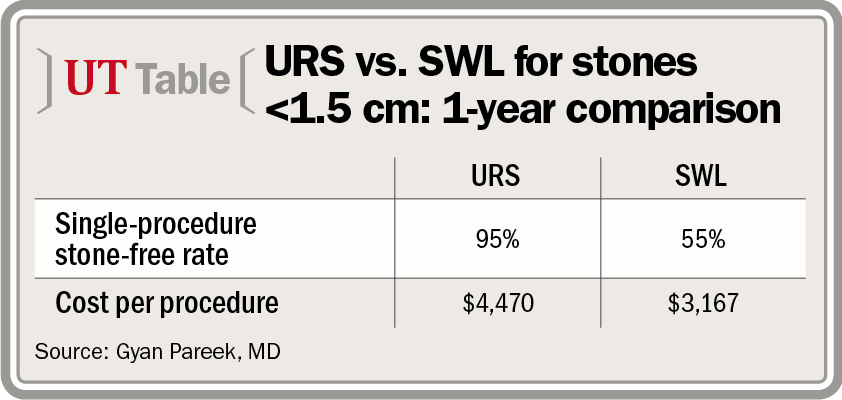Article
Study: URS found superior to SWL in stones
Author(s):
In renal stones smaller than 1.5 cm diameter, ureteroscopic lithotripsy (URS) is associated with superior stone-free rates compared with shock wave lithotripsy (SWL), according to a recent study.
Providence, RI-In renal stones smaller than 1.5 cm diameter, ureteroscopic lithotripsy (URS) is associated with superior stone-free rates compared with shock wave lithotripsy (SWL), according to a recent study.
RELATED: Flexible URS found safe, effective in stones <2 cm
In addition, a comparison of cost effectiveness of the procedures suggests that careful patient stratification and selection may increase the cost effectiveness of SWL, researchers found.

The authors reported superior stone-free rates for renal stones <1.5 cm for URS compared with SWL. Using a modeling system, the authors demonstrated that SWL is as cost effective as URS, if SWL success is as high as 65% to 67% for a single session. The study, presented at the 2014 AUA annual meeting in Orlando, FL, suggested that careful stratification and selection of stone patients might be the key to improving the cost effectiveness of SWL. The study has since been published in the Journal of Endourology (2014; 28:639-43).
Continue to the next page for more.
More on Stone Disease
Ureteroscopy increasingly used for pediatric stones
Urologist self-referral increases likelihood of CT, ESWL
How do you manage large kidney and ureteral stones?
“The problem is that many patients who fail shock wave lithotripsy will subsequently require ureteroscopy to treat their stones. In patients for whom SWL is successful, that procedure is clearly cost effective. The issue is identifying patients who are likely to fail SWL and require ureteroscopy-for those patients, SWL is unlikely to be a cost-effective treatment, and we feel that ureteroscopy should be considered as first-line treatment instead,” said first author Gyan Pareek, MD, director of kidney stone surgery and an associate professor of urology at Alpert Medical School of Brown University, Providence, RI.
“We postulate that SWL may be more costly when it is done in poorly chosen candidates, ie, those likely to fail. SWL is a key procedure in the urologist’s armamentarium. Along with my colleague at Massachusetts General Hospital (Brian Eisner, MD), we are currently assessing the patient selection process in patients undergoing shock wave lithotripsy.”
In the retrospective study, Dr. Pareek and his colleagues compared the cost effectiveness of renal calculi treated with URS compared to SWL in 171 patients (78 patients underwent URS and 93 underwent SWL as primary treatment). They analyzed patient age, stone diameter, stone location, and stone-free status for patients treated with SWL or URS over a 12-month period.
The authors obtained institutional charges from in-house billing and constructed a decision analysis model. One model compared the cost effectiveness of SWL and URS, while three other separate models were set up to reflect practice patterns for SWL.
Higher SFR seen with URS
The authors found that the single-procedure stone-free rate at 1 year for SWL was only 55% compared to 95% for URS. Cost per procedure was $3,167 for SWL compared to $4,470 for URS. The researchers’ decision analysis modeling indicated cost effectiveness of SWL when stone-free rates were 65% to 67%. For URS, cost effectiveness was estimated to occur when stone-free rates were 72% to 84%.
The authors say they believe it is paramount that clinicians identify which patients may be the most appropriate candidates for either treatment based on parameters such as stone diameter, density, and distance from the skin. They concluded that patients with low preoperative probability of SWL success might be better suited to URS from a cost-effectiveness perspective.
Dr. Pareek said currently there is no clear-cut standard treatment for patients, and treatment choices are often based on balancing potential success rates, complication rates, and patient preference.
“Over the last 5 years, there has been a trend to go away from shock wave lithotripsy, and we believe this may be due to poor patient selection. We are currently studying prediction tools which may help identify patients best suited for shock wave lithotripsy,” Dr. Pareek told Urology Times.
Subscribe to Urology Times to get monthly news from the leading news source for urologists.
Newsletter
Stay current with the latest urology news and practice-changing insights — sign up now for the essential updates every urologist needs.

















